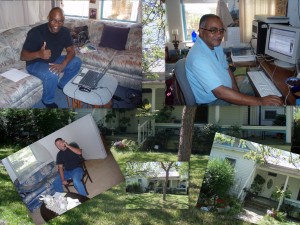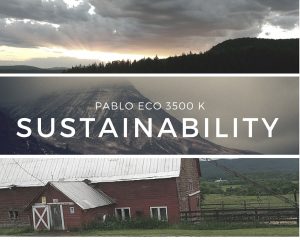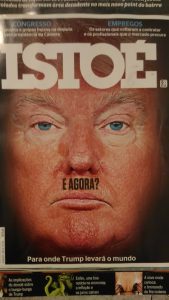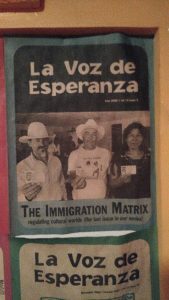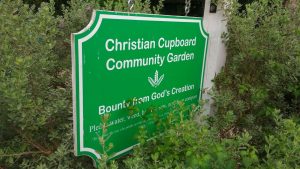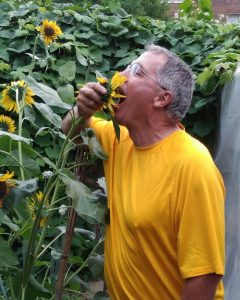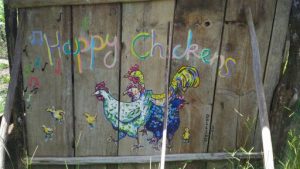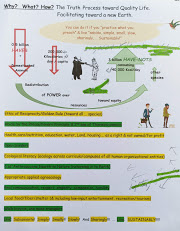(Pavel Martinka’s draft of an essay written after his 2006 visit to Cuba:
Stories for his children and theirs—and for others who might significantly help
to change the world in which they live)
Major Impressions
A Model for Realizing Sustainable Community?? Cubans are living a very low input life-style that is peaceful and relatively crime free, and that has a great foundation of holistic education and adequate health care for all–and that is developing urban and organic agriculture. It is of course highly significant that their premier politician has gained the honor and respect through the Revolution of most of the Cuban population, and he does govern as a dictator and the system is totalitarian http://historicaltextarchive.com/sections.php?op=viewarticle&artid=424 . Therefore, there are well-enforced limits to consumption, movement and development by humans. As I listened to my primary host (Dr. Rafael Ojeda) in Cuba in June of 2006, walked the streets of La Habana, watched the Cuban television channels, and participated in the meeting on Desarrollo Local, I could not help but think that this is perhaps a type of system much of the world may have to utilize to curb consumption, population growth, and destructive chaos in order to achieve maximum protection of our essential natural resource base and relative equity and justice for all, i.e. what might be called Positively Ethical Applied Community Ecology (PEACE)**.
Respect for Fidel and the Revolution. Cubans– … like Brazilians, Mexicans, Nicaraguans, Poles, Ukrainians, and US citizens, … –are beautiful and imperfect people using a functional but imperfect socio-political/economic (ecological) system in an attempt to achieve quality life. A huge majority of those over fifty who were the have-nots during the Fulgencio Batista years and previous years of U.S. colonization (the have-nots were by far the majority) have a tremendous respect and loyalty to Fidel for all his wonderful efforts. Younger Cubans may have respect for and loyalty to Fidel, but are more likely to overtly complain, to want considerably more, and even to attempt to flee Cuba. (For instance, I recently had a young Cuban student, Lisette, in my biology class who is probably in her early 20s. She credibly painted a very dark and deprived picture of her starving childhood in Cuba.)
What Right Does the U.S. Have to Decide for and Punish Others?!! It really is a
“ mortal sin” (or part of our/U.S. children’s “original sin”) to exert power over nations with economic/trade sanctions, embargos ,http://www.house.gov/paul/congrec/congrec2001/cr072601.htm , attempted assassinations and invasions, and trumped up-charges against alleged terrorists http://www.freethefive.org/ –all of which stifle charitable assistance and serve to “ostracize” the government and people of Cuba—truly creating a tremendous hurt to the flesh and stomachs–and hearts and souls–of millions of innocent people. We should work hard at lifting economic sanctions against Cuba and at serving up justice to all the Cuban people, including the Cuban Five.***
What We Might Do That Would Be Positive for Both Cuba and the U.S.? We could learn from Cuba a considerable amount about education, health care, organic and urban agriculture, living a low-input, energy-conserving lifestyle, and dealing with crime and terrorism. And since they are a nation with a biocapacity – ecological footprint deficit, they could certain benefit from some of the 33% of the world’s resources we (the U.S.) exploit and utilize (greedily–as 5% of the world’s population).
Cuba and Cuba-US Interactions Before June 2006
Knowing Cuba and Cubans Through Other Latin Americans: A Fortunate History of Knowing Some Really Great People. I was born in 1946 after my father returned as a Marine from the Pacific Front and vaguely remember President Truman as my first president. My first memories of Cuba were from reading**** during my early junior high school years about Fidel Castro in my Weekly Reader and in the daily San Antonio Express-News and Sunday’s San Antonio Light which were always stashed somewhere around our home. In the eighth grade and considerably later (1965-71), I heard about the fleeing of U.S. citizens and wealthy Cubans from Cuba.
Although I have seen many documentaries of and read articles on the CIA-supported attempt to overthrow the Castro government through the Bay of Pigs invasion of Cuba, I have no real memory of the “real-time-happening” of this fiasco. But of course, I do remember the Cuban Missile Crisis, the early publicity surrounding Miami Cubans, and alleged totalitarian atrocities by the Castro regime. And certainly more recent events including the Mariel boatlift and other less dramatic boat travels from Cuba, various U.S skirmishes including in the air, Pope John Paul II’s visit, the Elian Gonzalez capture and release to his Cuban father, and drug-trafficking-, monetary accumulation- and Swiss Bank account-allegations against the Castro Regime are clear in my mind.
Nevertheless, my knowledge of Cuba—a country somewhat comparable to Florida in size and population numbers (Cuba is 44, 200 square miles in size with 11 million people, whereas Florida is 58, 700 square miles with 16 million), and only 90 miles from that state–was very limited before my recent trip there. And of course in reality it still is!
Though my knowledge of Cuba is sparse, my work on farm-worker crews of Tony Cruz and Salame Gallegos involving mostly poor and socially-suppressed Mexican-Americans (beginning in about 1957), my other farm labor with mostly Mexican- and African-Americans, Vatican II, the Vietnam Conflict and my Navy experience, and the socially/politically active period of the 1960s in general, led me to want to deal effectively with status quo socio-political/economic injustice—and somehow overcome the powerful forces that maintain such inequitable systems. How I began to feel so strongly about a need for socio-political/economic (and ecological) change as a male gringo in a conservative rural community baffles many of my friends, especially since upon leaving home in 1964, I attended and worked for three conservative land-grant universities—one of which had had an all-male military tradition.
However, these land-grant universities I attended in the 1960s and 70s did have many foreign students from Dominican Republic and other Caribbean Islands, from Central America, from Mexico, and from Brazil and other South American countries. I gravitated to these Latinos/African-Americans and through these interactions in the 1960s and 70s—and through later studies and travels stimulated by these 60s and 70s interactions, I learned considerably more about Fulgencio Batista, Rafael Trujillo, the Anastasio Somozas, 64-85 military rule in Brazil, Augusto Pinochet, Alfredo Stroessner, and Leopoldo Galtieri (all involved in right-wing dictatorial regimes in various Latin American countries and which, with the exception of perhaps only the latter, the U.S. had largely supported). With regard to Chile and Pinochet, in the mid to late 1970s, I got a considerably different perspective from my Chilean friends than I had heard from U.S. channels, i.e., these Chileanos informed me about how we in the U.S. had disrupted one of the most democratic of countries through the CIA-instigated overthrow of Salvador Allende.
I also recall in 1981, the intense fear and paranoia my paraplegic tutor of Portuguese had of getting caught smoking marijuana by the police arm of the right-wing military President General João Figueiredo. Later (and much more recently) in our home, Father Roque, from Rio Grande do Sul, Brazil, expressed his hated of the U.S. and U.S. citizens for their support of the 1964 right-wing coup by the military in Brazil. (Father Roque had been tortured with electrical shocks to his genitalia because of his efforts to help leftists flee from southern Brazil into Argentina to escape imprisonment or death!)
The U.S. Propaganda “Machine”. Therefore, I entered Cuba with a conviction (based on history and experiences related to me by Latin American friends) that the U.S. did not have such a beautiful record of supporting socio-political/economic justice and equity– and that Fidel Castro and Che Guevara had been successful in making life considerably better for devastatingly-poor Cubans. Moreover, it seems that Fidel continued to work hard and think hard about how to make Cuban life better and to introduce programs and projects to that end, despite an onerous economic, commercial and financial embargo on Cuba since 1962 (through nine presidents–democrats and republicans) by the most powerful nation in the world. In addition, interactions with friends and acquaintances from Latin America, Poland, Uzbekistan, the Ukraine, etc. and travels to South America and Europe have indicated that we in the U.S. have historically gotten a paucity of information and knowledge via our government, public education process and news media—and that what we do get is much distorted.
Use of effective propaganda and mis- and dis-information in the U.S. was particularly brought home to me when I took a former Soviet physicist turned organic agriculture enthusiast (who had been on the USSR Academy of Science and was a friend of Andrei Sakharov), on a tour of south central Texas agricultural systems in the last days of former Texas Agriculture Commissioner Hightower’s administration. This incredibly interesting man was about my age and showed me black and white photos from the late fifties with beautiful vegetation-covered landscapes in Siberia, lovely Russian women, and of him working on an oil rig for wages in the Ural Mountains. His depiction of the Soviet Union was in many ways 180 degrees from that provided by our government and our news media in the 1950s-80s—i.e., the drab and dreary photos of Moscow and other large cities, the heavy unattractive women, the always snow-covered and blizzard-bitten Siberia, … and on and on. (To the contrary, in the 1990s one of my students from Cuba–also of about my age– who had “traveled the world,” told me that Moscow was the most beautiful cities in which she had toured. … Of course we all now know Russian women and women from other former Soviet republics can be very beautiful, e.g. we regularly see tennis players like Anna Kournikova, Maria Sharapova, etc. in ads–even if other more broad-based and more important knowledge of the former Soviet Union is still largely lacking by most U.S. citizens.)
Inequities and Serious Challenges. I also went into Cuba knowing that we in the U.S. are well over our carrying capacity, that biodiversity of all types is declining http://www.treehugger.com/files/2006/09/eo_wilsons_the.php in ecosystems and biomes all over the world, that all arable lands are being (over)utilized and desertified, that water quantity and/or quality is becoming a serious problem in much of the U.S. and the world, and that we in the U.S. use 33% of the world’s resources. Therefore one of the constant challenging questions in my mind is: how do we begin to change this disturbing situation and begin to protect our natural resources, redistribute the wealth, and provide quality life for all species? And as I began to prepare for a possible Cuban trip, I was certain that I/we can learn something about sustaining our natural resource/energy base via socio-political/economic (ecological) change from Fidel Castro’s Cuba!!
Visits to La Habana and San Jose de las Lajas
Cuba Can Certainly Feel Like Home. Some Brazilian friends recently complemented my wife and me by saying (paraphrased), “You came to Brazil in 1981, not because you thought it was exotic, but because you truly wanted to know its people, its language, its food, its diversions, its culture, the Land. You continue to come and participate significantly in community and feel a sense of place because you really love its people, language, food, diversions, culture, the Land.” … There is, I think, some truth to that. We attempted to immerse ourselves in Brazilian culture and culture from the time we arrived in late 1981, and we continue to do so. Brazil is not a vacation place for us, it is home. …
Something similar began to take place during my visit to Cuba. Rafael Ojeda and other Cuban hosts really made me feel at home in Cuba, and I am certain that continued research and interactions with Cuba and Cubans will enhance this. (And before continuing with this account of events surrounding and within my recent visit to Cuba—I want to make it clear that, similar to what we desire for our various Brazilian and Polish friends, etc., we wholeheartedly desire for my Cuban friends to visit us in our home in south central Texas and hopefully sense pleasant and long-lasting emotions (saudades) toward this part of the world. Despite these desires of my family and me, I do realize that it will be extremely difficult for this to take place.)
What Brought About This Trip, My Presentations at the Cuban Sustainability Conference, and What Were the Challenges in Getting from the U.S. to Cuba? As indicated previously, I had dabbled into Cuban international politics and their culture in the past. However, it was at an international meeting on Desenvolvimento Local at a Catholic University in Campo Grande, Mato Grosso do Sul–where I met Dr. Lazaro Camilo Recompenso Josepj, a Cuban working in western Brazil, and Dr. Rafael Ojeda Suarez, Director, Centro de Estudio de Desarrollo Agrario y Rural (CEDAR) de la Universidad Agraria de la Habana–that this recent trip really began. Rafael Ojeda and I served on a panel presentation/discussion at that meeting—and I was immensely impressed by his informative and thoughtful presentation, the thoroughness of his research and extension activities, and his wonderful personality which is enhanced by his complete humility. (During this meeting in Brazil, Camilo told a really funny story about how super-big the eyes of Siberian children got, when they saw his black fur-lined face during his studies and work in that area of the world—a region he said he really came to love for the beauty of its landscape and its people.)
After that meeting in 2003, Rafael and I interacted intermittently via email; but then in 2005 I received an invitation from him to attend el Segundo Encuentro International de Desarrollo Agrario y Rural: Por Desarrollo Local Sostenible, Un Mundo Mejor Es Posible (the Second International Meeting of Agriculture and Rural Development: Through Local Development a Better World is Possible). Even though I was unsure of whether I would be able to find the time and energy to travel to Cuba—and though I was particularly queasy about giving presentations at such an international meeting for a number of reasons, I did begin to research how I might proceed to enter Cuba.
(I might add that I put off the final decision to go until about one to two weeks prior to the meeting. Also, early on in considering the idea of traveling to this conference, I had decided that if I went–I planned to simply attend and learn. However, my dear friend Rafael pointed out–as renown Brazilian educator Paulo Freire would also have–that learning necessitates active participation, and Rafael stressed that he needed me to make presentations on developing sustainable community/PEACE** at a pre-conference workshop and during the proceedings of the conference. … Of course I eventually did so.)
After reading that U.S. citizens could be fined up to a quarter of a million dollars and receive 10 years imprisonment for entering Cuba “illegally” (in the eyes of the U.S. government), I made a whole-hearted effort to receive permission from the designated “appropriate”-governmental entity, the U.S. Department of the Treasury. I did so despite the fact that I also read that only hundreds (or less) U.S. citizens are given permission to enter Cuba each year by the U.S. and that thousands go “illegally” under U.S. law, but that most “illegal” U.S. travelers to Cuba receive no fines or imprisonment—and for those that are fined it is generally in terms of $7,500.
Anyway, I received a letter from the Treasury Department just prior to my planned trip to Cuba denying my requested license to enter. However, through a close friend at the college where I teach, a U.S. migration lawyer told me most U.S. citizens simply go to Mexico (she suggested Cancun) or some other country and then purchase airline tickets for entry into Cuba–and that the Cubans do not stamp U.S. passports. Therefore, I decided to head on to La Habana in this manner.
Despite this decision, I was still not really ready for such a Cuba trip. I had relatively recently had a major operation to correct a spinal cord problem and was still dealing with some problems with the functioning of my lower body, the semester was ending at my college and I had piles of portfolios to grade, and I was retiring and in the process of cleaning out my office. On top of all this, my wife and I were planning a month-long trip to Brazil.
Adding to the difficulties in truly being prepared for a truly educational and fulfilling trip to Cuba is the fact that I have always tended to be an undisciplined, not-do-all-your-homework, seat-of-the-pants operator (probably part of the reason why I did not turn out to be an effective U.S. Navy pilot in 1969/70– … Gracias a Deus!), and as indicated in other places herein, I had not adequately researched details of my proposed trip, stops along the way, or my destination in Cuban. Still, I trusted my Cuban friend Rafael who had encouraged me to come, and I eventually proceeded on to Cuba– unshaven and in old worn clothes, and with a tan (mostly artificial), and hoping that if the hotel and traverses to the meeting rooms were in perilous areas of La Habana—such as risky areas in which I had been in various other areas of Latin America (or the U.S. for that matter)–I might blend in as an average Cuban and not be targeted for any harm. … When I was younger my Brazilian friends oftentimes told me I could “almost” pass for being Brazilian—and I dreamed I might also pass as a Cuban and avoid some of the uncomfortable situations gringos might sometimes get into in south Texas—or other parts of Latin America.
However, 25 years later my same Brazilian friends now tell me I now appear to be puro gringo . … My wife reinforced this opinion upon my departure for Cancun. She stressed several times that I would never pass as a Cuban!!
Anyway, I did purchase a ticket to and from Cancun and anticipated catching a flight in the afternoon for arrival in Cuba as well as having two other chances to fly that day. However upon arrival in Cancun, I found that the flight times from Cancun to La Habana had changed, and that I would have to fly standby for arrival late that night in La Habana. Therefore, I called my wife back in Texas, and asked her to advise Rafael by email that I might–or might not–be arriving that night in La Habana.
Arrival in Cuba. I did make it onto the flight that night and arrived in La Habana at about 10 pm. I had traveled light and did not have to worry about the baggage claim area, and I proceeded to the cubicles with immigration officials, hopefully anticipating Rafael might be on the other side. I chose a cubicle with a pleasant-appearing young black woman whom I guessed might be easy on me. However, prior to reaching it I was stopped and questioned by a gentle but firm middle-aged state policeman.
“What’s your purpose in Cuba?”, “Where will you be staying?”, “Where do you plan to travel while here in Cuba?”, “What is the duration of your visit?”, “Who will you be meeting with?”, he asked in understandable Cuban. Upon receiving satisfactory answers, he told me to step up to the cubicle housing the young female immigration officer in uniform. And she proceeded to ask similar questions—also in understandable Cuban–but we did also exchange a joke and she proceeded to stamp some prepared entrance papers (but not my passport!!).
The small passageway through immigration opened up into a large room with an exit toward which I headed. As I headed for a small group of greeters, another state policeman proceeded to ask the questions doled out to me twice before. He told me to go on through, but then for some reason, quickly changed his mind and told me to stay put. He took my passport, meeting agenda, and telephone information I had for Rafael, and met with three other policemen to discuss my situation. After a few minutes of discussion and taking notes, he returned and told me I was free to go.
I headed through the greeters and found Dr. and Mrs. Rafael Ojeda sitting and waiting patiently for my arrival. After some embracing and cheek-kissing, we chatted a moment, and then headed out to the parking lot for Rafael’s car. As we arrived at his car, once again we were stopped by police, who began to drill Rafael. Rafael seemed to be a bit put off by this encounter and I asked Rafael’s wife what was going on, was I causing problems for them and was there something I could do? She pleaded ignorance and asked me to be patient.
Sure enough, after a few minutes of discussion we were on our way to the hotel in which Rafael had arranged lodging for me. Rafael explained that the police were only trying to protect tourists from exploitation by Cuban hustlers. (Evidently I did not pass for a common everyday Cuban—and most certainly was picked out as a true-blue gringo, and one from the United States.)
My Hotel, and Experiences in It and Its Surroundings. Upon arrival to the hotel and settling down in my room, I immediately began to be unsettled and concerned about having enough money. Although I had a MasterCard from a U.S. bank, only the dollars I had carried down in my concealed money belt would be accepted by the luxurious Melia Habana Hotel in which Rafael had arranged for me to stay. (Conveniently, it was the hotel in which our meeting would take place.) Nevertheless, I turned in and had a good night’s sleep.
(For several days after my arrival in Cuba, and after I saw the undiscounted prices of my Hotel Melia Habana, I worried that I might not have enough fula or U.S. dollars, which would have to be converted to Convertible Pesos via a 10% conversion cost. I expressed
this concern to Rafael and his wife, and indicated that perhaps I should move to a less expensive hotel. We left this in limbo for several days (not that I feared purgatory or hell–or expected heaven)—Rafael figuring that it would all work out and that I would be able to cover the expenses (besides, he had lots of more important things to worry about concerning the conference he was coordinating—and concerning taking care of other visitors), and I deciding that I could stand to do a lot of fasting (tengo un panzonito), and that perhaps I could borrow from a Mexican delegate I might befriend, promising I would repay him upon our return to Mexico and the U.S. In the end, with my fasting, no purchases of souvenirs, and a considerable discounted rate through Cuba’s tourist agency, UniversiTur, I did have enough to cover the Hotel Melia Habana charges!)
The next day (Saturday) Rafael had to work at his center at the agricultural university of La Habana just outside of La Habana (El Centro de Estudio de Desarrollo y Rural de la Universidad Agraria de la Habana).***** Therefore, I was free to relax in and get to know my luxurious and expansive Spanish-owned hotel and the rough concrete and rock- laden beach behind it, to read and work on my two presentations, and to walk the streets and view the beautiful tropical landscape sprinkled with beautiful tropical ladies (and men), the unpainted old buildings including wonderful old Catholic churches, the Russian Embassy and a small “supermarket” for tourists and Cubans who might afford it. The streets had relatively few people along them–many of them attempting to hitch a ride, a few bicycles, only an occasional bus, and some cars which included U.S. GM products, Fords, Chryslers and Willyses from the 1930-50s, some Russian Lada and Volgas similar to what I’d seen in the past in Poland and the Ukraine, and a considerable percentage of newer Japanese and European cars.
That Saturday evening, and during some other evenings (and during our trip later to Brazil with respect to the Venezuelan TV channel) I spent some time watching the Cuban channel and in particular the Venezuelan channel and President Hugo Chavez. I have some good feelings of hope about potential opportunities for the poor, repressed, disenfranchised in Latin America under the leftist governments of Hugo Chavez, and Lula da Silva in Brazil, Evo Morales in Bolivia, Michelle Bachelet in Chile, Nestor Kirchner in Argentina, and Tabare Vazquez in Uraguay. I have had considerable familiarity with the politics and political battles of Lula since our days of living in Brazil in the 1980s—and I have always felt solidarity with him and his politics. And of course, there has been considerable coverage of Chavez and Morales in recent press. However, I wonder if the average U.S. citizen really knows anything much of what is really great socio-political/economic change taking place in Latin America, and the potential for significant help to the really poor in these countries–if powerful countries like the U.S. would facilitate the process in a socially just and humble manner, … i.e., as a nation that is a true friend rather than an over-bearing know-it-all patron.
I do hope that Hugo Chavez–as a leader with the considerable power of oil reserves and revenues, will truly help desperate have-nots in his country and in others. But I am very skeptical!! I am amused by some of his antics– … one night while I was watching him while in Cuba he blurted out “You want cheap oil Mr. George W. Bush!! But no, no, no … you can’t have it!!!”—and it was really quite a funny show. On the other hand, I feel very uneasy when I see him toy with one of the 100, 000 Kalashnikovs he has coming from Russia, and I read of the million rounds of ammunition that will accompany them, and moreover, when I read that Venezuela plans to build and sell Kalashnikovs to other countries in the future, and when I hear that Chavez is empowering his military with subs and other military technology and arms. Therefore, as amusing as Hugo Chavez sometimes is and as hopeful some of his rhetoric and actions are—other antics and actions of this fellow really scare me!******
Touring La Habana and Its Environs with Dr. Rafael Ojeda! On Sunday Rafael picked me up and provided me a rapid, drive-by, walk-by tour of La Habana, his son’s apartment, his wife’s place of work, the area around his university, and the municipality of San Jose de las Lajas. Early on during this magnificent tour, Rafael pointed out what had been a hotel near my Hotel Melia Habana, that was now serving as a large hospital involved in cataract surgery and surgery for other eye problems–with clientele mostly from Venezuela and other Latin American countries. In La Habana he toured me through La Plaza Vieja, by the Gran Teatro de La Habana and the Catedral de San Cristobal de la Habana, by various museums including the Museo de la Revolucion and the Capitolio Nacional with its Museo Nacional de Historia Natural, by the Universidad de la Habana, through La Plaza de la Revolucion and many other plazas and along the lengthy seawall, the Malecon, with lovers dotted along it, taking in the view of the beautiful sea—or just taking in each other. He took me by the La Habana port docks and pointed to a huge cruise liner docked there. He showed me the Estadio America Latina, major government buildings and Fidel’s home—and the building which had housed the U.S. Embassy with it’s black-flag- and anti-U.S./anti-Bush billboard-sprinkled entrance.
We did take time to walk through La Plaza Vieja and a few other plazas, Rafael took considerable time to view the old Fortaleza de San Carlos de la Cabana across the bay from La Habana and explain the firing of the cannons at nine in the evening (announcing the closing of the old walled port city in the past). In the center of old Havana, Rafael demonstrated the restoration projects of old colonial building largely funded by the Spanish government and NGOs (international non-governmental organizations). He pointed out that the people who had been living in these buildings, continued to live in the buildings during restoration and that they were paid to assist with the restoration project. Upon completion of these projects, these habitants would be relocated to new housing.
Rafael demonstrated the Memorial Jose Marti (the La Habana airport is also named after this national hero) and proceeded to tell the story of Marti. This son of Spanish immigrants and newspaper publisher, became involved in anticolonial activism early in his life and was arrested for treason in 1869. After months of hard labor in a stone quarry and then exile to the Isla de Pinos (la Juventud), he was deported to Spain. After completing law school there, he lived in Mexico City, Guatemala, and several other countries—including another brief period in Cuba; but after additional conspiratorial and anticolonial activities, he eventually settled in New York. There he became well-known across Latin America for his relentless advocacy and organizing for Cuba’s independence from Spain. In May 11, 1895 he was killed in eastern Cuba during the Second War of Independence. During Marti’s career as a journalist, he had written many essays warning of U.S. imperialism. Following his death, imminent victory by his revolutionists was stolen from them by U.S. intervention three years later. (It seems ironic that the U.S. has named its major propaganda tools aimed at Cuba—Radio Marti and Television Marti—after Cuba’s hero who tried so hard to ward off U.S imperialism. … The U.S. has spent a half billion dollars on this effort that has less than one-third of one percent of Cubans as listeners.)
Rafael did make certain that I felt comfortable to ask any questions about politics, justice/injustices in Cuban, the government or Fidel. And he always responded openly and honestly, emphasizing that Fidel had done wonders for Cubans, that Cubans were prepared to protect Cuba and Fidel from invasions and assassinations, and that there are bright and energetic visionary politicians ready to take Fidel’s place and continue the Revolution.
I did query Rafael about recent changes since the Special Period after the Soviet Union collapsed, especially increased tourism and capitalism. He seemed to accept a need for both these processes, but emphasized that money and the influx of European and other tourists had resulted in a significant increase in drugs and prostitution. (Also, at some time early in the trip, it really dawned on me that my Cuban friends—even those participating in the meetings at Hotel Melia Habana, including Rafael, the primary organizer of the conference, could not/would not enter my hotel room upon my invitation. Movement in the hotel, and especially to the guest rooms, was closely monitored by guards in nice civilian suits—and Cubans were not allowed in the rooms of tourists.)
Travels with Rafael were like travels in Poland and the Ukraine with my wonderful amigo de Polonia, Kazimierz Wiech http://www.accd.edu/main/html/news/2005/033105_2.htm — … we didn’t eat much!! Sunday morning I munched on the mixture of mani, raisins and M&Ms my wife Betsy had prepared for me; however, the only other thing I had for sustenance on this long day that lasted until well after sundown, was a beer Rafael stopped and bought in a small square brick building by the streetside in La Habana and some tea and rum at Osvaldo Franchi-Alfaro Roque’s, i.e. Franchi’s, house.
We met Franchi at his small organic farm—which also served as a research and education operation—during our visit to San Jose de las Lajas. San Jose de la Lajas is in a productive dairy and sugarcane area of the province of La Habana near Rafael’s Universidad Agraria de la Habana. It has a progressive municipal government (I met a major local government leader for that municipality on that Sunday) whose various initiatives toward organic and urban agriculture, energy efficiency, more effective local health care, holistic education including in the culinary arts, seem to be relatively well-funded–at least in part through ALBA, Hugo Chavez’s Bolivarian Alternative for the Americas.
On that Sunday, we entered San Jose de las Lajas through a line of permanent “poster-monuments” memorializing Cuban revolutionary heroes. After chatting with the local government official, who Rafael noticed on the outskirts of the city, we made our way through scattered pedestrians, bikers (including the bicitaxis), and a few cars, to the urban farm/research-school of Osvaldo Franchi-Alfaro Roque, a former construction foreman who has converted what was a construction dump, to a productive educational farm.
As I indicated herein earlier, Franchi served us up some tea–and later some great Cuban rum—under a shaded area near his house while we informally discussed Cuban agricultural conditions and history in general, other organic and urban agriculture in the vicinity of San Jose de las Lajas, and his own vegetable, fruit, and seed production. He demonstrated his raised beds, shades and hothouses, fertilizer tea and organic “pesticides,” drip system, and a simple homemade mechanical irrigation timer which he had patented and which could be easily constructed in a farmer’s “spare” time from available resources. (See csanr.wsu.edu/Cuba/CubaTripReport2003-09-09.pdf and http://www.socialistviewpoint.org/sepoct_05/sepoct_05_29.html for other reports on Franchi’s operation.)
During this visit with Franchi, he discussed the various students whom he had mentored and advised and who stayed with him on his farm (one of the current doctoral students working with Franchi from Colombia, helped me later with my pre-conference presentation) as well as the many visitors from Europe and a few from the U.S. Before leaving his farm, Franchi made certain that I made an entry in his most recent guest book, as he demonstrated the lists of many guests from many areas of the world who had toured his farm. As we parted ways with some friendly hugs, he gave me several newsletters from CEDAR which mentioned his collaborative work with student and the university.
(While visiting Franchi, I could not help but think of the similarities between him and Malcolm Beck, founder of the compost and organic supply company, GardenVille, which originated here just north and east of San Antonio, Texas. Both Franchi and Malcolm are extremely intelligent, can-do and self-made men, who are voracious readers and excellent communicators and who know how to bridge the gaps between university know-it-alls, city-folk and campesinos. I related this to Rafael and dreamed out loud about how it would be wonderful to bring these two fantastically wonderful men together in each of their respective Lands!)
On our way back from San Jose de las Lajas to the center of La Habana, Rafael took me meet his Vice-Director of CEDAR, Luis Pena Ojeda. We found Luis near his brother’s home (a very basic and humble open shelter of concrete and raw wood)—shirtless, and skinning a rabbit. Since I wanted to demonstrate my Texan rural skills practiced on many a cottontail, jackrabbit, and Brazos county marsh rabbit (Two roommates and I lived on these spot-lighted, bread-bag contained, frozen leporids for the final year of my undergraduate studies at Texas A&M.), I pitched in on the rabbit-cleaning while we discussed rabbit-culture in Cuba and an established disease that made such an enterprise difficult, as well as the conference which would begin early that week. (By that time, Rafael had coerced me into being a co-moderator with Luis for a Thursday session on “Sostenibilidad Ambiental y Manejo de los Recursos Naturales.”)
One of the last things Rafael did on that Sunday was to take me to a beach in La Habana and allow me to quietly, spiritually experience a sun–larger than I had ever witnessed before–kiss the ocean’s horizon and then smoothly slide into the ocean in what seemed like a few seconds. I really appreciated Rafael for allowing me to experience what I might call wonder and a deep feeling of PEACE! It was a great ending to what was an amazing and wonderfully tiring, enjoyable day!!!
II Encuentro Internacional de Desarrollo Agrario y Rural
Pre-Conference and Conference Activities. After another day of street-walking, reading, and presentation-preparation, on Tuesday the conference in which I was invited was about to begin. When I went to the operational rooms of the meeting on Tuesday morning, I was greeted by and got to know better various members of Rafael’s family—his wife, his daughter-in-law, and later his son–and his staff and other colleagues, all of whom were eagerly volunteering and helping to make the conference a success. Moreover, Rafael’s Vice-Director, Luis Pena Ojeda also had his wife assisting with the management of the conference. (I decided that this was a good occasion to deliver gifts of books on sustainable community, Mexican pecan candy, and San Antonio and Texas arts and crafts/souvenirs to my hosts—and did so.)
The objective of the pre-conference as well as the principle proceedings of the planned conference, was in concert with my concept of a process of development of sustainable community or PEACE**. It proposed to bring together from various countries–principally Latin American–researchers, administrators, extension specialists, and other community members in order that they might holistically discuss successful approaches at achieving quality of life for all in local community, i.e., approaches to sustainable local livelihoods that are ecologically-sound, socially just and humane. Central themes included:
• nutritional security and sovereignty, and the importance of urban agriculture,
• environmental sustainability and natural resource management involving energy conservation,
• local human development and development of sustainable local governmental entities–including problems of globalization and urbanization,
• and sustainable management of knowledge and social capital.
I think it was particularly note-worthy that the efforts and successes presented were truly holistic and participatory, and were always monitored, evaluated, analyzed and discussed through various socio-political/economic (ecological) lenses. Moreover, presenters and audience-participants from Cuba, Peru, Mexico, Ecuador, Honduras (including a representative of CARE), Guatemala, Colombia, Argentina, El Salvador, Spain, the U.S., and Rome (an administrator from FAO of the United Nations) focused on empowering the poor (campesinos) and facilitating and hearing their active voice as leaders in research, extension, and sustainable development efforts.
I particularly enjoyed a presentation by CEDAR’s Physical Education and Community Recreation Chief, Alejandro E. Ramos which emphasized preventative vs. the curative side of individual and community mental and physical health, and showed the importance of involvement of all age groups, and all sectors of a community!! Also, my discussions with Justo Luis Orihuela Martinez–a former sugarcane farmer and currently a Sustainable Agriculture Specialist with CEDAR–of Cuban agriculture and transition of management mindsets during the Soviet and Special Period following the crumbling of the Soviet Union and Soviet support (centralization vs. decentralization, high inputs/throughputs/outputs vs. low, use of nasty persistent biocides vs. organic agriculture) were delightful! And I very much enjoyed listening to Carill Garay Valenza and other agriculturalists from Peru and discussing the challenges of working with organizations of campesinos in a socio-political/economic environment that marginalizes and ostracizes such groups and such work.
Some Sustainable Community Efforts with Which I’ve Become Acquainted Which Seem to Be Particularly Successful and Noteworthy. My presentations (the PowerPoint piece I utilized for the meetings in Cuba will be sent under separate cover) dealt with my knowledge of some of the most successful efforts at positively ethical applied community ecology** efforts of which I am aware. My talks were well-received; however, Carill and his colleagues did work me over after the pre-conference presentation–about the applicability of the cases I presented in their particular situations in indigenous and really tough and challenging Andean farmlands, … and about their skepticism that the model I presented could be successful for their campesinos under the current Peruvian socio-political/economic climate. Moreover, in the session which I helped moderate and in which I gave a presentation—a session with some emphasis on eco- and agro- tourism—a number of participants were not pleased with my skepticism of and disfavor with excessive tourism as a possible community component for true long-term community sustainability.
In addition, in one session I thought that Luis Pena made what was a too broad-sweeping, generalized statement about banning the use of fire in agriculture systems. When I proposed that fire can be a useful and appropriate tool in many (agro)ecosytems including in the tropics–if used wisely and judiciously–I was reminded that fuego es fuego, and that similarly to what I found in the scientific community in the Cerrado of Brazil, use of fire is it is a quite polemic subject. This is because of historical usage in the deforestation and destruction of natural habitat in Cuba, the taboos associated with fire inherited from European land management strategies and the “Smoky the Bear” mindset, its misuse in sugarcane systems, and some hard data demonstrating that use of fire in tropical systems can cause significant short-term and long-term harm.
I do want to emphasize that the meetings were productive and enjoyable! And outside of the meeting rooms, we did have some wonderful meals provided by the large restaurant at Hotel Melia Habana which consisted of fantastic seafood, pork and chicken, quesos, yuca, plantain, rice, calabaza, pepinos and various salads, a variety of beans and delicious tropical fruits including lots of guayaba y melon (sandia in Texas), ice cream and flan-type desserts, varios jugos de frutas, café y cafecito fuerte y muy sabroso, etc. (As is the case at such meetings, I had some wonderful discussions at meals with conference participants from Cuba, Spain, and Central America. At one meal I had an enlightening discussion with a long-time agricultural researcher/extension specialist who made me aware of a new book out on Fidel http://www.periodico26.cu/english/culture/book051806.htm .) And we had a couple of cocktail parties, one of which was out by Hotel Melia Habana’s immense pool. The latter cocktail featured amazing and beautiful swimmer acrobats performing an unbelievable synchronized swimming show. … I will send some photos under separate cover.)
Group Tour of San Jose de las Lajas. On Thursday we toured San Jose de las Lajas as a group.
• We entered an elementary school of about 500 or so students and were entertained by children’s songs (and I gave them a couple of baseballs from the U.S.),
• our group visited a medical facility which also serves to develop new doctors for the local community,
• all of us entered tidy homes with families living in them being retrofitted with new, more efficient electrical systems, lighting and appliances (something taking place across San Jose de las Lajas—and eventually across all of Cuba) (I gave a young man in one of the homes a Brazilian soccer shirt I had purchased prior to the trip.) ,
• we stopped at and were shown the office of a local government representative, the computer system and the local demographic data it contained,
• we ate snacks and had fruit juice at a small culinary school,
• we stopped to see a display of arts and crafts from the city (which included Franchi and his irrigation timer)
• and we were entertained in a local theatre by local young dancers and singers after which we all were brought up on stage for a participatory dance, and all given the microphone to say a few kind words about Cuba and Cubans.
During the stop at the school, I was impressed by the fact that although the rooms were not air-conditioned and were quite simple—and the books were mostly worn and tattered–all classes seemed to have a TV and oftentimes a computer. Moreover, as everywhere perhaps, these young students were full of energy and excitement–but they also really appeared eager to learn and seemed to be concentrating on the lesson and/or the teacher or TV, and to be on-task and focused.
At this school we were taken into the dental care section with 3-4 dental chairs, and told that all of the students had their teeth checked at least one time per year, and that curative work was done on an as-needed basis. We were also informed that regular physical exercise and general preventative health care is a high priority in schools in all of San Jose de las Lajas—and all across Cuba.
I did notice a list in a corridor of how a good communist should behave, which would have probably raised the eyebrows of some of our neo-cons/neo-McCarthyites here in the U.S. However, the list was not really different than that for a good citizen in our public schools here in the U.S., or for good Catholics or other good Christians in our parochial/Christian schools.
Back to Mexico and the U.S.
Despedidas. Since my wife had scheduled a trip to Brazil for that next Sunday, I had to miss the last day of the conference in La Habana. Thursday night I went to the front hotel desk to make sure that all was okay with my room payment situation (I had paid the discounted rate to the UniversiTur representative, and he was to pay the hotel)—and sure enough there was a glitch (i.e., my UniversiTur voucher could not be found). However, after explaining to the hotel representative that I had to leave at 5:30 am in the morning in order to catch a flight to Cancun, she made a call to her manager and he told her to go ahead and process me out.
Late that night, Rafael and his wife stopped by the hotel and brought me a few presents for myself and my family. And Rafael stressed in bidding me goodbye that the only thing he expected out of me in the future is true friendship and human and humane solidarity with the people of Cuba.
The next morning I hooked up with a fellow named Rolando, for a taxi ride to the airport. We had a wonderful conversation about his life and life in general in Cuba. This very open young man of about 30 years critiqued the current Cuba socio-political/economic system in many ways. He had problems with:
• lack of job opportunities (he had been a physical education teacher in a province to the east of La Habana),
• restrictions on moving from your home place (he was allowed to move to La Habana after demonstrating that there was a place available in his aunt’s home),
• economic inequities between those in government and those active in the Communist Party in Cuba–and others,
• and his experience/perception that the ration book (libreta) did not supply adequate food and supplies for Cubans.
!Es Cuba! !Es el mundo!
Espanol/Portenghol. I have some shame that–even after working in the field with migrant workers as a young boy and being around Spanish in south central Texas for much of my life; despite having Spanish as my language for my Ph.D., giving various lectures and other presentations through the years in Spanish, having a Texas teaching certificate in Spanish, and having traveled in a number of Spanish-speaking countries through the years–my Portenghol (as one Brazilian friend called it in the recent past) is still pretty miserable. Moreover, I really had to work extra hard at concentrating on and comprehending Cuban Spanish, which for me was contracted, run-on, incomplete and filled with colloquialisms. (I’m sure they would say the same about my Texan.) I feel quite confident that while I was in Cuba, Cubans understood my simplistic Portenghol, but my understanding of their Cuban Spanish sometimes had major gaps.
Arrival in Mexico and the U.S. Upon arrival in Cancun, the aduana official asked if I had any Cuban puros. When I said no, I got a green light and they quickly processed me on through. After an 8-hour layover in Mexico City, I made it back to San Antonio, where once again I got the green light and headed on home to Seguin.
Conclusions
Funds for CEDAR and Rafael. If I could easily get one thousand dollars or so of my own personal money into Rafael Ojeda’s sustainable development efforts across Cuba, I would do so on a moment’s notice. I would encourage others to contribute to his vast research efforts and his efforts at extension and diffusion of these research results across Cuba–from the provinces of Pinar del Fuego and La Habana to Cienfuegos to Las Tunas and Granma to Guantanamo. (Of course $1,000 might be a pittance in comparison to money being injected into his program at this time via ALBA, or the Bolivarian Alternative for the Americas and Hugo Chavez.)
Lifting the Embargo and Fighting Injustice. I believe we need to fight for a lifting of the embargo and for a thorough, fair and just investigation of the Cuban Five’s incarceration. http://www.chinadaily.com.cn/english/doc/2004-10/29/content_386819.htm It is a globalized world and economic/trade sanctions hurt little people, especially on an island that is well over its carrying capacity after having its natural resources devastated by Spanish colonialism, U.S. imperialism, and Soviet extraction.
Through Humility and Respect We Can Learn Much from Cuba. I do believe we should interact in a robust way with Cuba to communicate to learn about:
• Effective local health care for all
• Higher literacy rates and education of the general population
• Population and consumptive growth regulation
• True organic agriculture and urban agriculture
• Holistically and intelligently dealing with terrorism
Solidarity. I hope that I and others honor Rafael Ojeda’s request for solidarity with him, his people and his efforts across Cuba with local development toward sustainable community. He is a very good man! And his Cuban participants in PEACE** are good people!!
Additional Web Sites, Etc. You May Want to Visit
http://www.awiu.org/Cuba/index.html (Report with points similar to mine by American Women for International Understanding.)
http://www.foodfirst.org/node/361 (Excellent book on Cuba’s agricultural transformation.)
http://www.yesmagazine.org/article.asp?ID=1462 (Interesting perspective on how North Korea and Cuba responded to oil shortages in different ways—and how the rest of us might deal with impending shortages of this fossil fuel.)
http://www.brianwillson.com/awolcuba.html#misery (Contains summary comments you may wish to scan over.)
http://www.organicconsumers.org/2006/article_460.cfm (Organic/urban agriculture in Cuba.)
http://cubajournal.blogspot.com/2006_02_01_cubajournal_archive.html (Within this blog site is an interesting piece on the history of Cuba and Fidel.)
csanr.wsu.edu/Cuba/CubaTripReport2003-09-09.pdf (Google this and you’ll find a wonderful report on a tour of organic agriculture in Cuba)
……………………….
* Footnote re. Es Cuba: Es Cuba is a book by Lea Aschkenas (2006) that points out what I already knew to a limited extent from a few Cuban friends, i.e., that Cubans in Cuba readily critique their system and life in Cuba, but they do also attempt to work hard to make it better. (!Es Cuba! !No es facil!) On the other hand they do accept that there are limitations to what they can do given their limited resources, the U.S. embargo, and the craziness of micro- and macro-politics. Obviously, I believe there is some of this critically-thinking mind-set and sociological process going on in all peoples and countries of the world—or there should be.
** Footnote re. concepts of sustainability: The process of a dynamic conservation and development of sustainable community has been most eloquently described by farmer, poet, essayist, and philosopher Wendell Berry in 1979. “To live, we must daily break the body and shed the blood of Creation. When we do this knowingly, skillfully, reverently, it is a sacrament. When we do it ignorantly, greedily, clumsily, destructively, it is a desecration.”
It is a particularly local process. Nevertheless all human players must also work hard at being global. It involves initial rapid and long-term continuing appraisal of all ecological resources in a management unit (watershed?), e.g. natural capital, social capital, cultural capital, political capital, human capital, financial capital, built capital. Moreover, strategic planning, policy development and action planning and implementation utilizing appropriate developmental processes and appropriate technologies long-term conservation and sustainability; and continuous monitoring, analysis and evaluation, and replanning are key subsets of this sustainable process. Efforts termed sustainable livelihoods http://www.livelihoods.org/ , holistic management http://www.context.org/ICLIB/IC25/Wood.htm , Ogallala Commons http://www.ogallalacommons.org/ , natural systems agriculture http://www.landinstitute.org/vnews/display.v/ART/2000/08/05/377bbbe53 , local development http://translate.google.com/translate?hl=en&sl=pt&u=http://www.agdr.goias.gov.br/desen_local_int.htm&sa=X&oi=translate&resnum=10&ct=result&prev=/search%3Fq%3Ddesenvolvimento%2Blocal%26hl%3Den%26lr%3D%26rls%3DGGLD,GGLD:2004-52,GGLD:en , research into historical and conventional ecological footprints and energetics in Europe by Helmut Haberl http://www.iff.ac.at/socec/staff/haberl.php , research and activism by Stuart Hill in Australia http://www.zulenet.com/zulenet/see/chair.html into socio-political/economic (ecological) processes conducive to conservation and development of sustainable community, research and activism world wide by Miguel Altieri http://translate.google.com/translate?hl=en&sl=es&u=http://www.agendaorganica.cl/altieri.htm&sa=X&oi=translate&resnum=7&ct=result&prev=/search%3Fq%3Dmiguel%2Baltieri%26hl%3Den%26lr%3D%26rls%3DGGLD,GGLD:2004-52,GGLD:en into sustainable human cultures, processes and technologies, and some of the efforts in the Northwestern U.S. http://www.yesmagazine.org/article.asp?ID=905 and by conservation biologists http://www.stanford.edu/group/CCB/ seem to me to be particularly contributing significantly to this PEACE process. However, there are many, many admirable activities contributing to this process in universities, NGOs and numerous other entities across the humanosphere.
*** Footnote re. the U.S. embargo on Cuba and other warring actions of our beloved empire: The embargo on Cuban is one of the many strong-arm tactics we have made as a nation which has a long-history of exerting its power and desire for more on others less powerful. Of course many in this country continue to support these tactics—and even more outrageous tactics such as pre-emptive strikes, secret prisons, torture and restriction of civil liberties on a broad-spectrum of peoples.
I have a close relative who is exemplary of this. In the 1960s and 70s, his outward appearance of curly long hair, his old worn clothes and old Volkswagen Beetle, his musical preferences, and various actions and statements, made him to appear superficially to be a stereotypical leftist liberal. Searching for meaning in life, he ran away from his Catholic roots and was captured by a Christian cult in California. He eventually left this restrictive “communal” life with Shiloh and since then he has become Bible-/Weekly Standard- thumping Reaganite/W. Bushite neocon who is also supposedly a Pro-Lifer. But despite this “Pro-Life” stance, he also seems to possess the warmongering mindset of the Fort Worth red neck in Chip Taylor’s Another Fort Worth Friday Night, who is lamenting over the Viet Nam Conflict and who gruffly emotes, “Next time we’ll win it!”
This relative who is on the extreme opposite side (from me) of this chasm we have in liberal and right-wing mindsets in this country, constantly uses the phrase often used by other neo-cons (i.e., of the masses)–“because of people like you, we lost the Vietnam War,” as if it’d be great to continue to bomb, napalm, and Agent-Orange that wonderful part of the world, and continue to kill Vietnamese, other Asians, U.S. citizens and citizens of other Western countries and do what is really important in life (or death)—win wars!! He has not learned that only corporations and war-time speculators and opportunists “win” wars for the short-term, and that most other life-forms continue to suffer long after the fighting has ended. His Uncle Bain (after whom I am named) wrote from the German front shortly after the Battle of the Bulge, and just a few days before he was killed in combat, (paraphrased) “They’re taking pretty good care of us over here. Sometimes we sleep in a foxhole, sometimes in a pillbox, but sometimes we spend the night in an abandoned German home. Moreover, we get at least one warm meal a day! It’s not like the Pacific where Alton (my father) is. They’ve got this war well-organized over here. … And man if they’ll get around to organizing peace as well as they’ve organized war, we’ll definitely have a long-lasting peace.”
Uncle Bain and my Dad–and most others involved did not win in World War II. They lost lives and those dear to them!! Moreover, many of these old soldiers know you can not win at war (in Vietnam—or Iraq …)—that is why they will not talk about war. They knew the terrible realities of war and a militaristic mindset. Deep down–though they may have trouble in articulating it in a world of war and the language of war–they know PEACE is the only way.
**** Footnote re. the conservation, anti- technological/gadget/television mindset in the Alton Martin family: We purchased a television in ca. 1963, and for a number of years thereafter, my father only allowed viewing on weekends. Therefore, I really did not see video images (propaganda) of Cuba, Fidel Castro and Che Guevara and the Cuban Revolution and related activities until after ca. 1964.
***** Footnote re. Dr. Rafael Ojeda Suarez’s (Director) center at the Agrarian University of Havana: From a translation of their webpage: “The Training Center of Agrarian and Rural Development (CEDAR) of the Agrarian University of Havana, founded the 26 of June of the 2003 is based on the design and application of a model of management of sustainable development at local level, sustained in a system of interinstitutional, interdisciplinary, prospective and participatory knowledge and information. This system will facilitate the decision- making of the social actors of the community for the strategic planning of the agrarian and rural development at municipal level–on a scientific basis. It will have applied investigation models developed under the demands, problems and challenges of the surroundings—through a systems approach. Its operational range is national having concrete actions in the provinces of Pine of the River, Havana, the Tunas, Granma and Guantánamo through their agrarian university institutions.”
******Footnote re. Hugo Chavez: Hugo Chavez is certainly not all wrong when he tears into the U.S., its citizens and el Diablo con azufre for their hubris, ignorance, greedy use of natural resources and energy, killing of innocent civilians through the many wars it has begun or entered, and other socio-political/economic (ecological) disruptive activities. Moreover, it seems that one has to ask, “How can we criticize Venezuela and Iran for arms buildup and arms sales when we, as 5% of the world’s population have by far the most armaments, and have almost one-half of the world’s armament market and more than 2.5 times that of the second and third highest armament marketers? http://www.fas.org/asmp/fast_facts.htm http://en.wikipedia.org/wiki/List_of_countries_with_nuclear_weapons
We–like Hugo Chavez–are pecadores y diablos. But perhaps his sin is venial—and ours mortal??
7S’s / VV->^^
pbm
